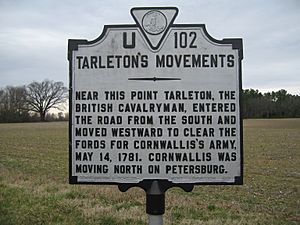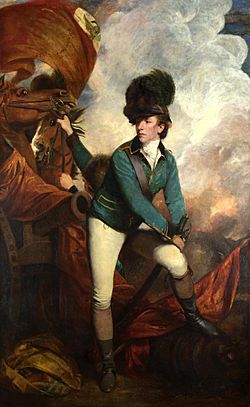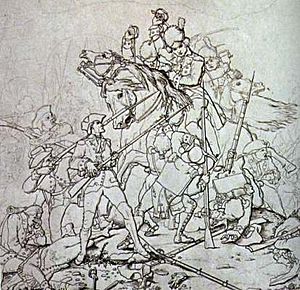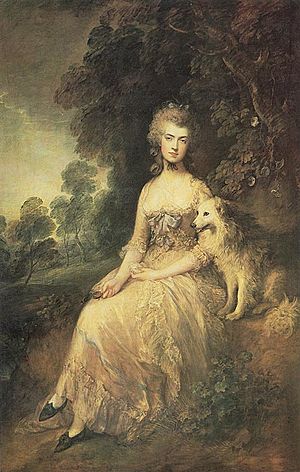Banastre Tarleton facts for kids
Sir Banastre Tarleton (born August 21, 1754 – died January 15, 1833) was a British general and politician. He is most famous for leading the British Legion during the American Revolutionary War. After the war, he also served in Portugal, Ireland, and England.
Tarleton's cavalry soldiers were often called "Tarleton's Raiders." For most of his time in North America, he led the British Legion, a special unit formed in New York in 1778. After returning to Great Britain in 1781, when he was only 27, Tarleton became a Member of Parliament for Liverpool. He was a well-known politician, even though he had a reputation for being a bit wild when he was younger. Tarleton came from a family involved in the slave trade, and he strongly opposed those who wanted to end slavery in Britain.
Contents
Early Life and Military Start
Banastre Tarleton was born in Liverpool, England. He was the third of seven children. His father, John Tarleton, was a merchant and served as the Mayor of Liverpool. His family was involved in the transatlantic slave trade.
Banastre's younger brother, John, also joined the family business and became a Member of Parliament.
Banastre studied law at University College, Oxford, starting in 1771. In 1773, at age 19, he inherited £5,000 from his father. He spent almost all of it in less than a year. In 1775, he bought a position as a cavalry officer (cornet) in the 1st King's Dragoon Guards. He quickly showed he was a skilled horseman and a good leader. Because of his talents, he rose through the ranks to lieutenant colonel without needing to buy more promotions.
American War of Independence
In December 1775, at 21 years old, Banastre Tarleton sailed to North America. The American Revolutionary War had just begun. Tarleton joined Lord Cornwallis on a mission to capture Charleston, South Carolina. When that mission failed, Tarleton joined the main British Army in New York.
In December 1776, Tarleton was part of a scouting group that captured American General Charles Lee in New Jersey. Tarleton surrounded a house and forced General Lee to surrender. General Lee was later exchanged for other prisoners.
Tarleton's service in 1776 earned him a promotion to brigade major. He was promoted to captain in 1778. He fought in many battles, including the Battle of Brandywine. In 1778, he was wounded during an attack on an outpost.
Capturing Charleston
After becoming the leader of the British Legion, a group of American Loyalist cavalry and light infantry, Tarleton went to South Carolina in early 1780. His "Tarleton's Raiders" helped Sir Henry Clinton capture Charleston. This was part of the British plan to regain control of the southern colonies.
The Battle of Waxhaws
On May 29, 1780, Colonel Tarleton and 149 mounted soldiers caught up with 350 to 380 American soldiers led by Colonel Abraham Buford. Buford's men refused to surrender at first. After many Americans were killed, Buford ordered his soldiers to surrender. However, Tarleton's forces reportedly ignored the white flag and continued to attack.
In this event, 113 American soldiers were killed, 203 were captured, and 150 were badly wounded. The British had 5 soldiers killed and 12 wounded. The British called this the Battle of Waxhaw Creek. American rebels began to use the phrase "Tarleton's quarter" to mean "no mercy given."
An American surgeon, Robert Brownfield, said that Colonel Buford raised a white flag, expecting fair treatment. But when Tarleton's horse was shot, his soldiers thought their commander had been killed. They then attacked the Americans without mercy.
Colonel Tarleton later wrote that his horse was shot, and his soldiers, thinking he was dead, became very angry and hard to control.
Whether these reports were fully true or not, stories of British cruelty made many colonists support the American Revolution. On the other hand, Tarleton believed that being tough on civilians was better than being mild, saying that moderation "did not reconcile enemies." Later, at the Battle of Kings Mountain, American soldiers, remembering Waxhaw Creek, killed Loyalists who had surrendered.
Later Operations
In South Carolina, Colonel Tarleton's British Legion was often bothered by Francis Marion, known as "The Swamp Fox." Marion was an American militia leader who used guerrilla warfare tactics. Tarleton could not capture him or stop his operations. Marion was popular among anti-British South Carolinians, who helped him. Tarleton, however, made colonists angry by taking their cattle and food.
Tarleton helped Cornwallis win the Battle of Camden in August 1780. He was promoted to major. He defeated Thomas Sumter at Fishing Creek, but was less successful against Sumter at Blackstock's Farm in November 1780.
On January 17, 1781, Tarleton's forces were almost completely destroyed by American General Daniel Morgan at the Battle of Cowpens. Tarleton and about 200 men escaped. During the battle, Tarleton was wounded in his right hand.

He was successful in a small fight at Torrence's Tavern and took part in the Battle of Guilford Courthouse in March 1781. Tarleton then marched with Cornwallis into Virginia. There, he led several small missions. One raid was on Charlottesville, where the state government had moved. He tried to capture Governor Thomas Jefferson and members of the Virginia legislature. This raid was partly stopped by Jack Jouett's ride, which allowed Jefferson and most of the lawmakers to escape. Tarleton destroyed weapons and supplies.
Tarleton was promoted to lieutenant-colonel in June 1781. In July 1781, some of his forces were reportedly involved in Francisco's Fight, a skirmish where colonial Peter Francisco fought nine of Tarleton's soldiers.
During the Siege of Yorktown, Cornwallis told Tarleton to hold Gloucester Point. On October 4, 1781, French and British cavalry, led by Tarleton, fought at Gloucester Point. Tarleton was thrown from his horse, and the French pushed the British back. The British surrendered Gloucester Point to the French and Americans after the surrender at Yorktown in October 1781. After the surrender, senior British officers were invited to dinner by the Americans, but Tarleton was not. He returned to Britain at age 27.
After the War
Tarleton had lost two fingers from a musket ball in his right hand during the Battle of Guilford Courthouse. This injury actually helped him in elections back home. His injured hand is hidden in his 1782 portrait by Sir Joshua Reynolds.
After returning to Britain, Tarleton wrote a book about his experiences in the war called Campaigns of 1780 and 1781 in the Southern Provinces of North America. In it, he presented his own actions in a good light and questioned some of Cornwallis's decisions.
Political Career
In 1784, Tarleton tried to become a Member of Parliament for Liverpool but lost. In 1790, he won and was re-elected to the House of Commons until 1812, except for one year. He supported Charles James Fox, even though they disagreed about the American Revolutionary War.
Tarleton spoke on military topics and other subjects. He was known for supporting the slave trade because it was important to Liverpool's economy, as it was a major port in the triangular trade. He worked to protect the slave business with his brothers and often mocked those who wanted to end slavery.
In 1808, he became governor of Berwick and Holy Island. In 1815, he was made a baronet, and in 1820, he received a high honor called the Knight Grand Cross of the Order of the Bath.
Later Military Career
Tarleton continued to serve in the army. He was promoted to colonel in 1790, major-general in 1794, and lieutenant-general in 1801. He became a full general in 1812. He had hoped to lead British forces in the Peninsular War (against the French in Portugal and Spain), but the position was given to Wellington. He also held military commands in Ireland and England.
Personal Life
Tarleton had a long friendship with the actress and writer Mary Robinson. She helped him write many of his speeches for Parliament. His portrait was painted by famous artists like Joshua Reynolds and Thomas Gainsborough.
In 1798, Tarleton married Susan Bertie, who was the daughter of the 4th Duke of Ancaster. Tarleton did not have any children.
He passed away in January 1833, in Leintwardine, Herefordshire.
Legacy
- Tarleton Street in Liverpool is named after him.
- The ship Banastre was named for him.
- A house at the site of his defeat in Pennsylvania was called "Tarleton."
- The "General Tarleton Inn" in Ferrensby, North Yorkshire, is named after him.
- Tarleton Square apartment complex in Charlottesville, Virginia seems to be named for him.
- Tarleton Street, in Centreville, Virginia, is named after him.
In Popular Culture
- In the 1835 novel Horse-Shoe Robinson, Tarleton is shown as a strong military leader.
- In the 1959–1961 Disney TV series The Swamp Fox, John Sutton played Colonel Banastre Tarleton.
- In the 2000 film The Patriot, the made-up character Colonel William Tavington (played by Jason Isaacs) was based on Tarleton.
- In the 2006 film Amazing Grace, Tarleton (played by Ciarán Hinds) is shown as a strong supporter of the slave trade.
- In the TV series Sleepy Hollow, a villainous British officer named "Colonel Tarleton" appears in a flashback.
- Tarleton is a minor character in Diana Gabaldon's novel Written in My Own Heart's Blood.
Captured American Battle Flags
In 2005, it was announced that four rare battle flags, captured by Tarleton from American soldiers in 1779 and 1780, would be sold at auction in New York City. These flags included the guidon (a type of flag) of the 2nd Continental Light Dragoons and other standards. The flags were sold on Flag Day in the United States (June 14, 2006).
Tarleton Helmet
Tarleton introduced a special leather helmet for the British Legion, which he also wore. It had a fur plume (or wool for lower ranks) sticking out at the front. This helmet is shown in Sir Joshua Reynolds' portrait of Tarleton and was named after him. This helmet was used by British horse artillery and light dragoon regiments for many years. It was based on a type of helmet popular in other European armies.
See also
 In Spanish: Banastre Tarleton para niños
In Spanish: Banastre Tarleton para niños




